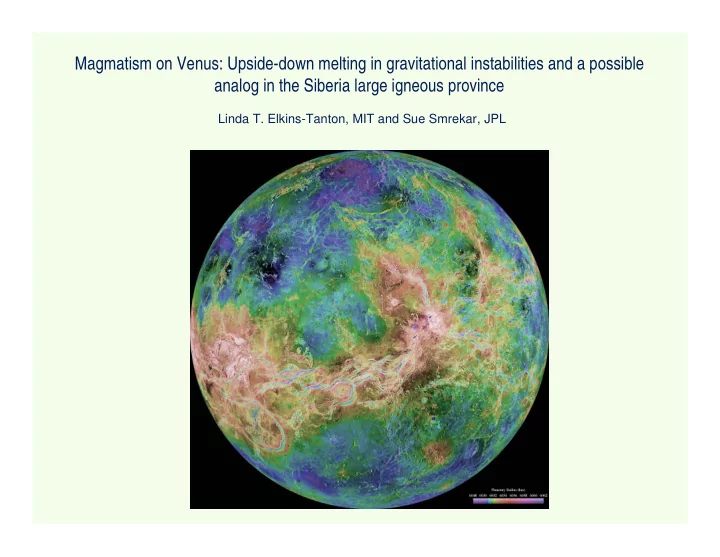

Magmatism on Venus: Upside-down melting in gravitational instabilities and a possible analog in the Siberia large igneous province Linda T. Elkins-Tanton, MIT and Sue Smrekar, JPL
Volcanic flows (NASA/JPL) (NASA/JPL)
(NASA/JPL) Pancake Domes (NASA/JPL)
Channels (NASA/JPL) (NASA/JPL)
Outline � Hypothesis: Combinations of lithospheric gravitational instabilities and thermal upwellings can create a wide range of melting source regions in the absence of plate tectonics (Parmentier and Hess, 1992; Dupeyrat and Sotin, 1995; Smrekar and Stofan, 1997; Hoogenboom and Houseman, 2005) � Source regions can melt to form a range of magmas: Upside-down melting � These magmas are consistent with the viscosity range inferred from volcanic forms on Venus 1. Numerical experiments of gravitational instabilities 2. Petrologic modeling of resulting source regions and magmas 3. Comparison with possible Earth analogs
Gravitational instabilities • Viscosity low enough to allow flow • Lithosphere denser than surroundings
Starting conditions for numerical models • Spherical axisymmetric version of ConMan called SSAXC • Domain 128x128 nodes = 500 km 2 • Temperature-dependent viscosity • 5% density contrast placed in lithosphere • T surface = 460 ° C • T p = 1300 ° C in mantle • Initial viscosity = 10 19 Pas
Mantle melting in an annulus around the instability
Upside-down Melting Phase boundaries from Kawamoto (2004), Litasov and Ohtani (2003), Ohtani et al. (2004), Herzberg et al. (2000), Takahashi et al. (1993), Tronnes and Frost (2002), Schmidt and Poli (1998), Grove (unpublished), Yaxley and Brey (2004), Dasgupta and Hirschmann (2004), Dalton and Presnall (1998)
Upside-down Melting What are possible source compositions? peridotite, eclogite, and metasomatized analogs
Regions drips pass through as they sink
Regions where upside-down melting may occur
Melt compositions Data from Klemme et al . (2002); Pertermann and Hirschmann (2003); Pertermann (2004) G 3 ; Falloon and Green (1999); Baker and Stolper (1994); Walter (1998); Fedorenko and Czamanske (1997); Kogiso et al . (2003); Hirschmann et al . (2003) Viscosities calculated according to Shaw (1972) and Bottinga and Weil (1972)
Magma viscosities
Alkaline massifs in Arctic Siberia 102E 104E 70N
Trip map: Guli 10 km
Trip map: Guli
Trip map: Guli
Guli long distances
Conclusion • Viscosity differences may be due to temperature, volatile, and alkali contents, not primarily silica content. • One hypothesis: cooler eclogite melts form pancakes; melts from hot, metasomatized peridotite source or carbonatites make channels
Recommend
More recommend